If you’ve ever wondered why, or how the orange Ladybug differed from the red then you’re not alone. We have all come to love the little red Ladybug, but what’s so different about the orange ones? I’ve researched this thoroughly and I’m going to share with you what I know.
Asian Lady Beetle vs Ladybug. For this, we’re going to make comparisons between the Asian Lady Beetle and the common Ladybug, such as the two-spot, seven spots, or nine-spot Ladybird Beetle.
So, what is the difference between the Asian Lady Beetle and the Native Ladybug?
Their color, markings, and behavior differ, the Asian Lady Beetle has a distinct white M (or W) on their pronotum (the part above the head) along with large white ‘cheeks’. They have varied colors and are generally larger in size. They’re also more aggressive than native Ladybugs.
How come?
Plus there are other factors that make the Asian Lady Beetle stand out from the Native Ladybug.
The Entomology – The Science Bit
The two varieties both share the same Kingdom, Phylum, Class, and Order. These insects belong to the
- Animalia kingdom
- Arthropoda Phylum
- Insecta Class
- Coleoptera Order
- Insecta Class
- Arthropoda Phylum
The Coleoptera Order belongs to beetles. That’s why calling them bugs isn’t actually correct.
The main point of difference is that the native Ladybugs belong to the Coccinellidae family, while their Asian cousins belong to the Scarabaeidae family. However, despite both of them belonging to the same kingdom, phylum, class, and order, the similarities are actually limited.

Asian Lady Beetle vs Ladybug – Difference in Sizes
The Ladybugs found in the Coccinellidae family vary between 0.8 to 18mm in size. However, the common Ladybugs, as we have come to call them, vary around 3 to 6mm in size. Their Asian cousin, on the other hand, is more stoutly built. As a result, they are generally larger in size.
On average an Asian Ladybird will be about 7 to 15mm in length. Their body is 10mm wide, which is again, slightly more than their North American counterparts.
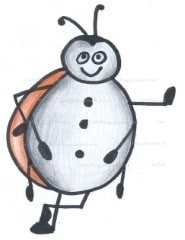
Interesting Fact…
The Asian lady beetle is also known as the Japanese Ladybug.
Show me More Amazing Facts About Ladybugs
Asian Lady Beetle vs Ladybug – Difference in Colors
Native Ladybugs are commonly found in bright red color. However, they can also exist in pale red. The Ladybugs will have small white ‘cheeks’ on their pronotum and sometimes there might not be any white spots as well. The shell or outer skeleton of the Ladybug will be bright red with white spots.
The orange Ladybirds (Asian variety) will generally have more spots, typically ranging between 2-19. In addition to their being orange and yellow, the Asian Ladybirds can also be found in Brown, Black, Yellow and White varieties, but not in Purple.
The green ladybugs are a bit harder to identify since it’s actually a greenish-hue of the yellow Ladybug. Most of them have more than 10 spots. Some of the spots might be hard to detect if they’re faint, this could be because newly emerged Lady Beatles have yet to form their spots, or because older Ladybugs’ spots can fade.
Asian Lady Beetle vs Ladybug – Difference in Habitats
Both varieties of Ladybirds enjoy their outdoor time. The native Ladybug spends almost all of its time in the wild. They generally do not go indoors, unless by accident, or forced by humans. Even during winter, they’ll prefer to find empty tree barks or a heap of dry leaves as their overwintering spot.
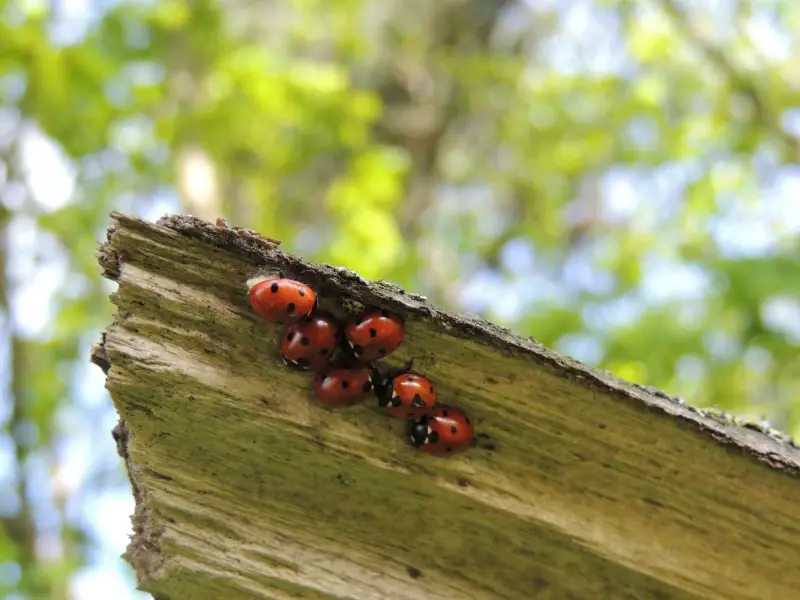
Their Asian cousins, on the other hand, due to their previously warmer climate, will gravitate toward and invade homes to find a place of warmth during their overwintering phase. Otherwise, their habitats remain the same.
Asian Lady Beetle vs Ladybug – Difference in Behaviour
The Ladybug usually has a pretty mild temperament. The Asian lady beetle is quite different from its counterparts. As mentioned previously, the Ladybug usually stays outdoors and does not invade homes even during its overwintering phase.
But the Asian lady beetle does. Not only that, Lady Beetle is actually quite aggressive. They are known to attack any larvae and eggs, even those of Ladybugs.
When interacting with humans, Ladybugs rarely bite, but their Asian cousins are known to bite, which for the most part leaves a harmless red mark, but in some cases can cause rashes, pink eye (conjunctivitis), asthma, or an allergic reaction. If you find you are bitten by a Ladybug and it produces more than just a red mark then seek medical advice.
When they feel threatened and need to protect themselves, they tend to leave a foul-smelling yellow secretion. The liquid is secreted from their leg joints and is known as ‘reflex bleeding.’ While the secretion isn’t dangerous, it does leave a stain on any upholstery and walls.
Another point of difference in their behaviors is that the Ladybug doesn’t congregate in such large numbers as the Asian Lady Beetle. It’s not uncommon for them to live alone, and look for another member of the species during their reproduction phase.
The Asian lady beetle is more social. They amass in often huge numbers and can stay together in tight spaces. In recent times, they’ve been known to infest homes in and around farms in North America and Europe.
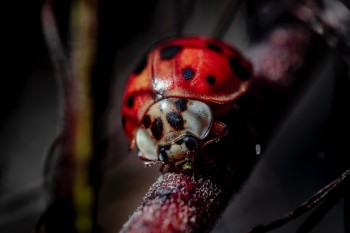
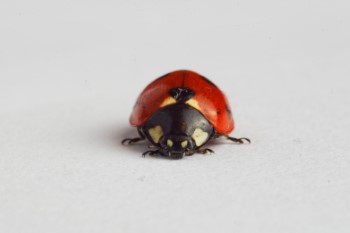
How Asian Lady Bird Beetles Spread
The Asian Lady Beetles, as the name suggests, are actually native to parts of Asia, like Japan, Pakistan, and the Indian subcontinent. Authorities in North America identified a growing pest problem on their farms and felt the Asian Lady Beetle may be the answer.
The gradual increase in aphids, spider mites, and other similar pests had driven farmers to the widespread use of chemical pesticides. But the increase in chemical pesticide use has a proportional effect on food pricing and an inversely proportional effect on human nutrition.
As a result, the authorities looked to the Asian Lady Beetle as a natural solution, which would reduce the cost for farmers, and also allow them to use lower volumes of pesticides.
The Asian variety of Lady Beetle is an avid eater. They like nothing more than to eat their way through their favorite meal, which is mostly aphids. This voracious hunger is what distinguishes them more so from the native species found in the states.
The Asian species were first imported in 1916 and again in the 1960s. The USDA (United States Department of Agriculture) first released them in South Carolina, Louisiana, Georgia, Mississippi, California, Washington, Pennsylvania, Maryland, and Connecticut.
Soon after, the insects escaped from the greenhouses and made their way across the continent, before eventually migrating to the UK and the rest of Europe where they are also aggressively threatening to overwhelm native Ladybug numbers.
In addition to the imported release by the Government, it’s also likely that the beetles made their way into North America through freight containers. Carried unintentionally inside shipping containers, perhaps whilst wintering within the containers, before making their way inland. Here they just needed two factors to work for them – food and shelter.
The key to nutrition for Lady Beetles are aphids, spider mites, and over 200 attracting varieties of plant s
Since the reason for bringing the Asian Ladybird was the aphids themselves, there was obviously no initial shortage of food sources in the first few years. But soon enough, the Ladybirds decided that staying put in one place had no meaning as food became more scarce.
They went searching for a wider playground and slowly spread from one farm to another and from one state to another. Before long, the Asian Lady Beetle took descended upon fresh farmsteads, and the farmers were more than happy to oblige. And why not?
They were helping to keep the pests in check and allowed the farmers to grow their crops more abundantly. It meant happiness for all the parties involved – farmers, consumers, and Ladybirds.
However, given that the Asian Ladybirds are voracious eaters, they soon started taking overseas trips as they spread into Europe. Unsurprisingly, they have ensured that their presence is felt on the European continent, in the same manner, they did in North America.
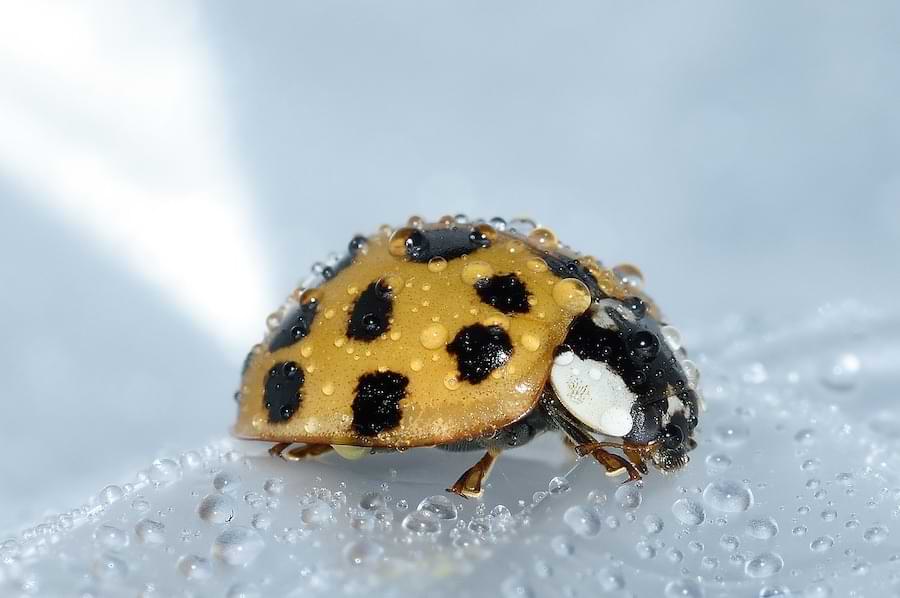
Why Asian Lady Beetles Are Spreading Fast
Thanks to the vast acreage of North American farms, Asian Lady Beetles had plenty of food. In 2017, the vast areas farming soybeans, pea, and cereal crops allowed them plenty of aphid sources.
The dry weather in these areas allowed the aphid population to increase, which again invited Lady Beetles into the farm. As a result, the Asian Beetle had a wide pool for its food source.
During the winter, they took to invade homes and shelters to use for their overwintering spots. The warmth of the homes drew them during the winter and they took refuge in the sidings, wall crevices, light sockets, and foundation spaces.
When the spring came, they exited their spots to look for food again and slowly begin the reproduction process. This continuous onslaught has led to an escalating rise in the number and spread of the Asian Lady Beetle.
But, that’s not all….
The infestation problem has become so intense that as far up as Manitoba in Canada, authorities get regular calls from homeowners, especially those living in the countryside and near farms.
Homes and barns can be filled with Lady Beetles during the onset of winter. They aren’t reproducing inside the homes. But the level of infestation becomes clear when spring comes. And indeed the level of infestation in the current year will be dependent on the aphid population.
If there’s a good harvest and the weather remains favorable, there will be higher chances of an increase in the aphid population. A higher aphid population would indicate more food for the Lady Beetles and more scope for reproduction – I guess that’s just how nature works!
However, the increase in the food supply isn’t the only factor that has allowed the Asian variety’s population to grow.
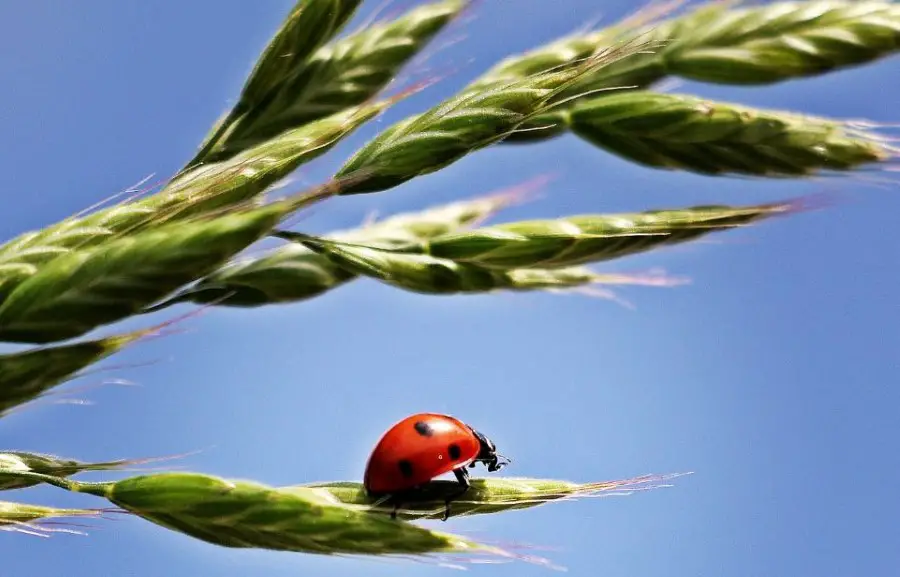
Asian Lady Beetle Can Be Cannibalistic!
It is not unusual for Asian Lady Beetles to eat their native competitors – the Ladybugs. Particularly where food does become more scarce and particularly prone are the Larvae of Ladybugs.
The Asian Lady Beetle can also carry fungal parasites inside them. This parasite is known as microsporidia. It’s certainly not harmful to humans, but when the native Ladybug population started to nosedive, scientists started investigating the reasons.
The Asian Ladybirds are immune to the effect of the parasite, but for other insects it’s lethal.
Additionally, Asian beetles are extremely aggressive. They attack and eat the larvae and eggs of other insects like butterflies as well as the native Ladybugs.
As a result, they’re able to knock out the competition at different stages in the lifecycle. A culmination of all these different factors has allowed them to dominate their new battleground.

Got More Ladybug Questions?
Head over to my list of Quick Fire Frequently Asked Questions
Asian Lady Beetle vs Ladybug – Which One Is The Good Beetle?
Actually, none of them are bad. Both beetles are good but have their specific uses. While there’s much information regarding the Asian beetle overrunning the native Ladybug population, there are few specific reasons for that other than its more aggressive nature.
You see the native Ladybugs are actually part of the natural ecosystem. They form part of the predatory cycle and as a result, they need to compete with other predators to survive.
This helps keep their numbers in control. It’s actually similar to how the Ladybugs help to keep the aphid population in control.
When the USDA decided to import the Asian Lady Beetle, they didn’t account for the various ecological factors. They counted on the Lady Beetles being voracious eaters. Since they can eat up to 115 or more aphids a day, the USDA found this a natural solution to their aphid problem.
But they did not take into account the potential effects on other ecological balances.
See, the Japanese Lady Beetle (same as the Asian lady beetle) causes no such problems in Japan. There’s a very simple reason for this. There are predators in Japan that keep the population in check. When the USDA imported the beetle, they didn’t think that the aggressive cousin might not have a natural predator in North America.
Additionally, their native competitor is certainly more passive, or at least – less aggressive. As a result, the native population began to shrink while the invasive Lady Beetles dominated their food source.
However, that does not necessarily mean that the Asian beetles are ‘bad’.
They are the way they are because they have evolved according to their natural ecosystem. In a way, they’re very helpful, considering how they were instrumental in reducing the aphid population. But it’s best that they are left to their own natural habitat.
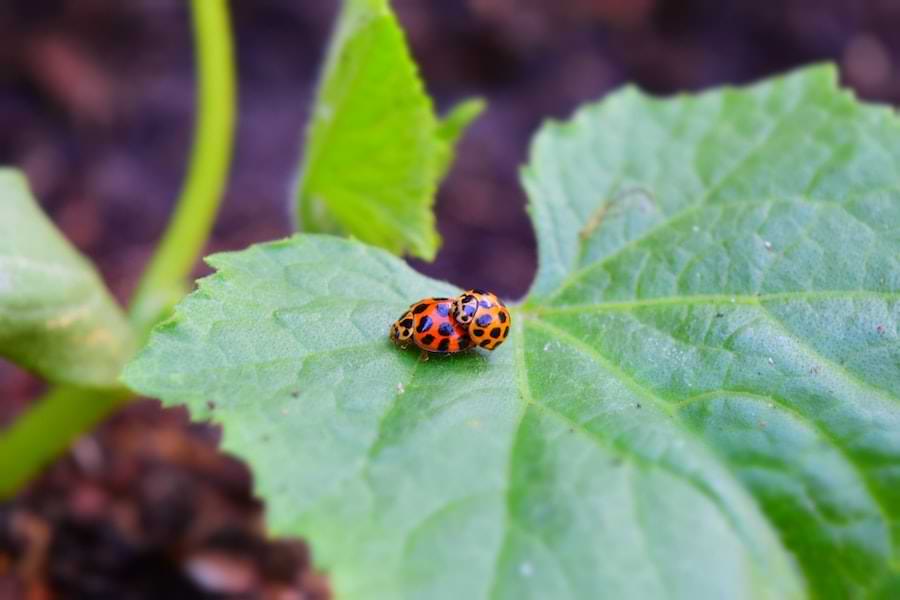
Asian Lady Beetle vs Ladybug – Conclusion
The Asian Lady Beetle is a beautiful cousin of our common Ladybug. They come in a variety of colors and can be identified with a ‘W’ or an ‘M’ marking on their head. They also have white spots on the ‘cheeks’ which are less pronounced on the common Ladybug.
They were imported into North America due to their aggressive behavior and high appetite. But soon enough, that turned out to be a downside rather than a benefit
Whilst they were in Japan and East Asia, where they’re native, these problems did not exist. The availability of natural predators helped to keep their population in check and the warmer climate meant there were fewer home invasions.
As a result, the Asian cousins though aggressive, are really just the result of global trade (since there’s that theory of them being accidentally imported on freight ships) and/or unfortunate agricultural planning.
If you’re living in North America or Europe and facing infestation problems, you can ask for help from your local pest control technicians and take preventive measures.
I hope you’ve found out here all you need to know about Asian Ladybeetle and Asian Lady Beetle vs. Ladybug.
I do hope our much loved 2 spot, 7 spot, and 9 spot ladybugs are able to survive amidst such an onslaught, but they’ve survived for thousands of years so far, and life finds a way, so I expect they’ll survive one way or another.
If you enjoyed this and like me you love Ladybugs, then feel free to browse my collection of curated Ladybugs Gifts as well as my free Educational Resources – Perfect for class projects and home-schooling activities.

Related Questions:
Are Asian Lady Beetles Harmful? Asian lady beetles are not harmful as such. However, they are more aggressive and can bite. The bite itself is mostly harmless as the mandible does not hold enough power to cause lasting damage. But in some cases, the bite has been known to cause rashes, conjunctivitis, asthma, or allergic reactions.


